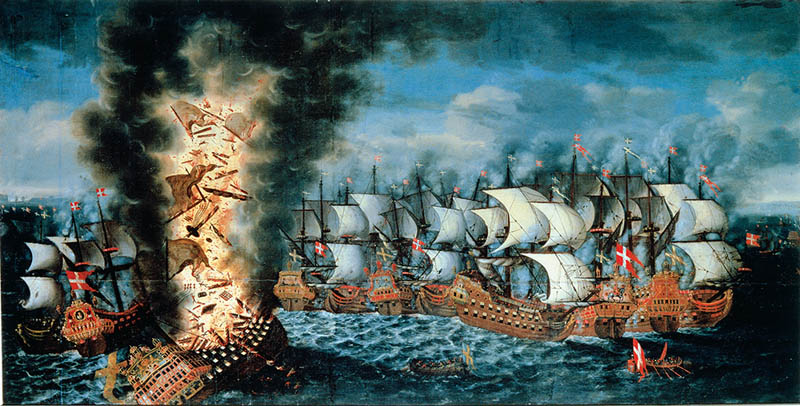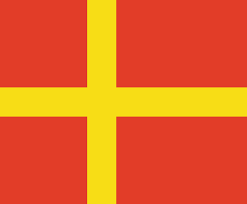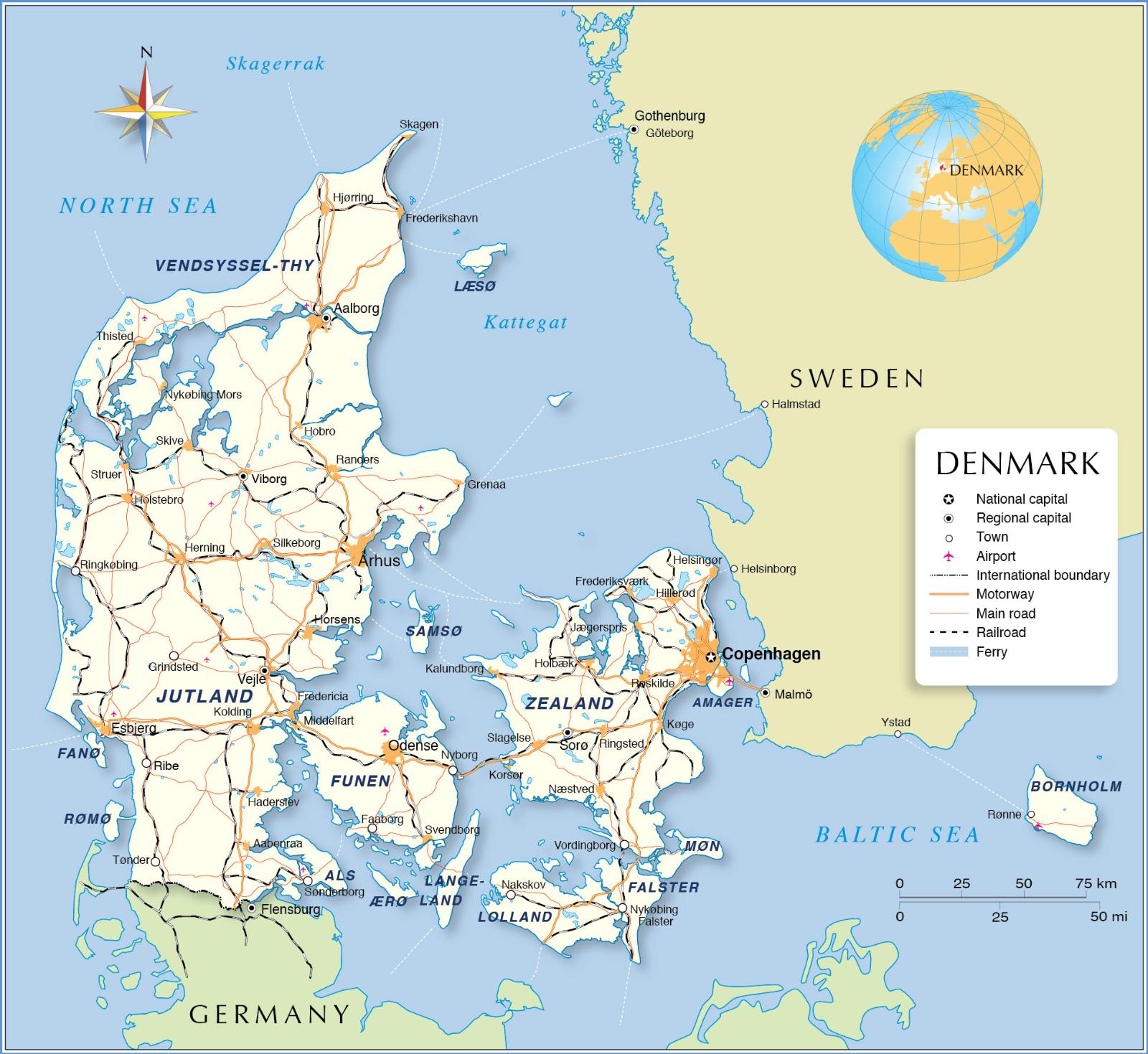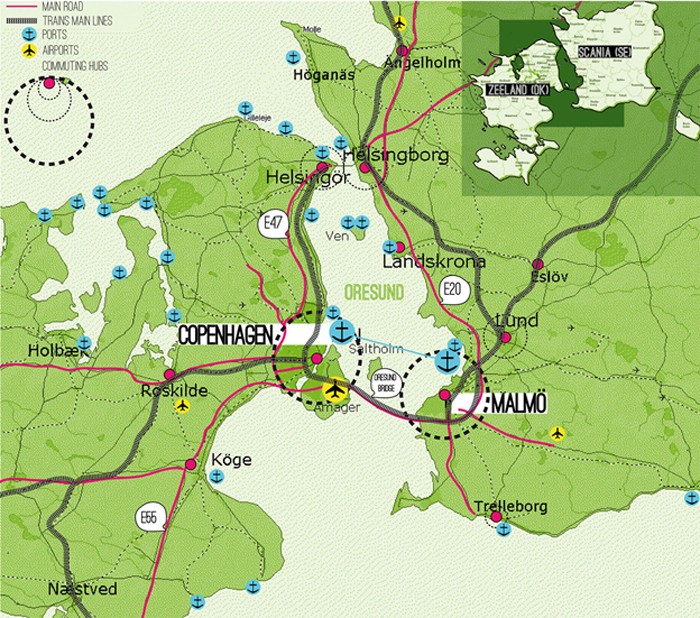The Danish-Swedish Rivalry and Scanian Regionalism
by Norman Berdichevsky (October 2019)

Battle of Öland, Claus Møinichen, 1676
Southern Sweden, known as Skåne (Scania in English) with its own distinctive regional flag in red  and yellow (see illustration) was in terms of historical memories, even language, as well as physical geography, landscape, soils, vegetation, and climate much more similar to the remainder of Denmark than to the rest of the Swedish peninsula.
and yellow (see illustration) was in terms of historical memories, even language, as well as physical geography, landscape, soils, vegetation, and climate much more similar to the remainder of Denmark than to the rest of the Swedish peninsula.
The present Swedish county of Scania covers around 3% of Sweden’s total area (see map), but its population of 1,250,000 comprises 13% of Sweden’s total and includes the country’s third largest city (Malmö). Scania was actually larger in relative area and population when it was a recognizable part of the Danish Kingdom from the earliest appearance of Denmark as a unified state in the 11th century until it was annexed by Sweden in 1720 after the last of numerous wars between the two countries.
 These geographic and historical facts explain the anomalous peripheral location of the Danish capital with regards to the rest of the country—the peninsula of Jutland sharing a border with Germany, the major islands of Zealand and Funen amidst the “Belts” (sea passages between these two major islands) and many smaller islands strewn around the North Sea and Baltic. The population of these areas often felt neglected by the Danish authorities and king residing in Copenhagen. Outside of Zealand, Danes felt remote from the seat of power, especially in the age before modern bridges and air travel.
These geographic and historical facts explain the anomalous peripheral location of the Danish capital with regards to the rest of the country—the peninsula of Jutland sharing a border with Germany, the major islands of Zealand and Funen amidst the “Belts” (sea passages between these two major islands) and many smaller islands strewn around the North Sea and Baltic. The population of these areas often felt neglected by the Danish authorities and king residing in Copenhagen. Outside of Zealand, Danes felt remote from the seat of power, especially in the age before modern bridges and air travel.
Read more in New English Review:
• The Putin System: An Investigation
• Inoculate Against Rhinogradentia
• Past and Future Gulags, Part 1
By contrast, much of the Scanian population felt that Copenhagen was within easy reach, just a short ferry ride away (and now a short drive over the modern Øresund bridge—see map). The Danish island of Bornholm out in the Baltic lies only 80 miles from the Swedish coast but is 300 miles from the closest Danish harbor. This meant a much longer travel time when sailing was the primary means of transport in the past yet Bornholm remained stubbornly Danish in spite of the much greater distance and refused to accept the last peace treaty that ceded it to Sweden!
The important connection between the Baltic and the North Sea passing through the narrow straights of the Belts, the Sound, and the coast of Scania enabled Denmark to exercise a monopoly on trade and collect a toll on all ships passing through these waters due to its dominant sea power, a fact of political and military geography deeply resented for centuries by Sweden.
The Many Dano-Swedish Wars for Control of Scania, the Baltic and The Sound (Øresund)
Few neighboring countries were at war so often with each other from the Middle Ages until the end of the Protestant reformation as Sweden and Denmark, in much the same way as France and Germany from Napoleonic times until World War II. For most Americans, this comes as a surprise, since both countries along with the rest of Scandinavia share a modern image of largely homogeneous peaceful states that remained neutral throughout most major modern European conflicts. The many similarities in culture, language, Lutheran state religion, the common reputation as “welfare states” with advanced social legislation have obscured much of the crucial past and present differences in outlook such as those that led to the American Revolution and the final separation from England.
Danes and Swedes could not agree on the form of the union between them. The differences separating them were not magnified by an ocean but rather by the constant fear of invasion along a common land boundary on the Swedish peninsula and narrow stretches of water.
In the Middle Ages, Norway found a union with Denmark as the only reasonable solution to avoid the total dissolution of society following the Black Plague. Sweden also felt that the advantages offered by a union with Denmark, briefly called a “loving bond,” under a united crown offered strategic advantages. This union of all three states in 1497, under the Danish Queen Margrethe I was a political move designed to be a federation of equals, but it was not to last and left a residue of antagonism and rivalry.
This situation resembled the case of the English governors and the American colonial houses of representation. The Swedish and Danish nobility were diverse sources of power after Sweden separated from the Danish crown. Growing resentment of the Union led to the total eviction of the Danes from Scania, a move that would award Sweden with a share in the control of the narrow straits and an end to Danish monopoly on tolls. With two such contrasting visions of their future and status, war followed war from 1434 until 1720.
In the sixteenth and early seventeenth centuries, Poland, Denmark, and Sweden fought these wars for Dominium maris baltici (“Lordship over the Baltic Sea”). It was Sweden that eventually encompassed the Baltic Sea, a goal that made it Mare Nostrum Balticum (“Our Baltic Sea”). This achievement finally realized in the 1720s was successfully accomplished at Danish expense, though it did not enjoy the sympathy of Scania’s population. Although Denmark had the ability to mobilize allies, most notably the Russians, Poles, the Dutch, and the English, the end results were successful for Sweden, and a terrific blow to Denmark’s prestige and image as the leading Scandinavian power.
These memories persist and have not been erased by joint membership in the European Union. In 1992, Denmark initially rejected a popular referendum to adhere to the Treaty of Maastricht, promising integration within the European Union. It had to be cajoled and pressured into full membership by the power of France and Germany, so many Danes today can understand the dilemma of the Brits who wish to leave the EU and are being pressured from all sides to remain. The Danes were able to win an agreement to ensure that Greenland (part of the Danish Kingdom) remain outside all the provisions of the European Union and jealously protects its natural resources including mining, fishing, and immigration.
The Local Scanian Language/Dialect
The local spoken “dialect” in South Sweden, known as Scanian, is considered by some a separate language and others as a regional dialect. It was looked on by the Swedish government as an archaic reminder of past Danish rule.
The gradual transition to standard literary Swedish over several centuries resulted in the introduction of many new Swedish characteristics into Scanian, especially regarding vocabulary and grammar. In spite of the shift however, Scanian dialects have maintained a pronunciation, as well as details of grammar and vocabulary that in some aspects differ from Standard Swedish and show a closer relationship with Danish, German, and Dutch (and occasionally English). The degree of contrast between Scanian dialects and standard Swedish is often compared to the differences between British English and Australian English. Among the younger generation of Scanians, there is a renewed interest in regional identity and the local dialect.
The result was also a strong national enmity between the two countries. A final blow was dealt when Sweden picked the winner in the Napoleonic wars and Denmark was forced to cede control of Norway to its bitter enemy, adding a final humiliation and promoting Sweden to the undisputed position as the “big brother” of “Norden” (The North).
This military and diplomatic victory was bitterly resented in both Denmark and Norway as an example of Swedish imperialism, prompting the great Danish clergyman N. F. S. Grundtvig to publish a pamphlet in 1813 denouncing “the aggressive spirit that now dominates Sweden” and “acts as the servant of evil.”
Although “Denmark proper” (Jutland, Fünen, and Zealand) was never conquered by Sweden, it lay under the threat of renewed attack and invasion. This danger and ignominy served as a cause of irredentist hopes for centuries and prolonged the hatred between the two countries. To this day, the Danish royal anthem sings of a naval victory of their King Christian IV over the Swedish fleet in 1644. By contrast, the Swedish anthem never even mentions the name of the country but exclaims, “I will live and die in ‘Norden'” (a term, like Scandinavia, referring to the entire region).
The “Swedification” of Scania
When Sweden’s King Carl Gustav X landed in Scania on March 5, 1658, he was met by a delegation of the region’s bishop, Peder Vinstrup, and clergy who hailed him in effusive Latin verse but notably absent were any other figures of the previous Danish administration, local nobility, or common people. The local Scanian nobility quickly sought an accommodation under the threat of being deprived of their lands, but an intermittent guerilla war of resistance was launched by the common people who refused to accept Swedish rule permanently, and guerilla warfare resisting the Swedish occupiers endured for more than fifty years.
On the island of Bornholm, the Swedes were actually ejected by the local civilian population who demonstrated such determination that the Swedes withdrew.Bornholm was hardly worth additional effort by the Swedes to recover it but the policy followed in the rest of Scania after a brief period of promised “autonomy” became one of “Swedification,” imposition of the Swedish language, law, church, and school system, and internal duties on trade. Swedish King Carl X heartily agreed with the proposal of Bishop Vinstrup to establish a new Swedish language university in Lund that would function as a center of the administration.
Swedish occupation forces had to resort to force to suppress resistance, burned land and destroyed crops in reprisal for violent resistance. Local people who participated in any act against Swedish rule were labeled guerillas and punished severely. Between 1658 and 1720, historians estimate that mass executions, starvation, illness, forced emigration, and the movement of refugees into Denmark reduced the population of Scania by nearly forty percent. As with the American colonial resistance to the British, a central issue was refusal to accept the forced quartering of Swedish troops (or Polish mercenaries) in private homes.
Growth of Scanian Consciousness
As elsewhere in distinctive regions of Europe, there has been a trend to cultivate a local regional-cultural identity. In 1944, a Dane and a Swede, Ellen Hartmann and Valfrid Palmgren Munch-Petersen, wrote a special dictionary titled Farlige ord og lumske ligheder i dansk og svensk (Dangerous words and awkward similarities in Danish and Swedish) that should be read by anyone needing to master the neighboring language and avoid embarrassing mistakes. Of course, Scanians with a mastery of both standard languages enjoy these jokes more than anyone (just like Brits and Americans).
Recently, several humorous Scanian dictionaries of the spoken vernacular have been published but there is no Scanian language standard; the choice of words to be included is always under debate.
How Far Apart are Swedish, Danish, and Scanian?
The Danish and Swedish popular press, especially the mass circulation tabloids, delight in playful teasing and taunting the other “sibling” rival and it sometimes reaches grotesque proportions, especially if Sweden and Denmark are scheduled to play an important international soccer match. Although educated people regard this pandering to old prejudices as the cheapest form of sensationalism, its continued emotional long-term appeal cannot be doubted.
Danes and Swedes will often prefer to converse in English rather than speak their own languages with each other. The written form is sufficiently similar so that the intended meaning of texts can be generally understood but nuances in intonation, pronunciation, and the distinctly different meanings of closely sounding words provide an endless form of humor.
Is the Hatchet Buried?
All this may seem like making a mountain out of a molehill for many foreign observers who imagine that the Scandinavian peoples are so similar they should have long ago buried the hatchet. Indeed, all the Scandinavian states remain among the most stable in the world politically. They cooperate in many economic and social areas such as the EU, the joint SAS airline, NATO (except for neutral Finland and Sweden) and are culturally, socially, and linguistically similar, but maintain a distinct sense of political separateness. Joint membership in the European Union has not erased these historical memories or sense of differences that matter (just as they have not between Portugal and Spain).
History and especially geography have determined much of their foreign policy and prevented them from following a common one or joining in an alliance. Norway and Denmark joined NATO due to their inability to maintain their neutrality in World War II, while Sweden continues to be neutral. All three jealously guard their independence. Denmark’s close proximity and border conflict with Germany over South Jutland (Schleswig/Slesvig) prevented Norway and Sweden from considering a Scandinavian alliance before the World Wars with the prospect of German expansionism and revenge. Finland, bordering the Soviet Union and with territorial losses sustained in 1940, made it difficult for the other Scandinavian states to join an alliance (regarded as potentially directed towards the Russians) that would endanger them in order to protect Finland.
A few flies in the ointment are of particular concern for the residents of Scania. These included the proximity of the former Swedish nuclear power plant in Barsebäck facing Copenhagen and the Danish coast of Zealand. Finally, after two decades of protests from Danish governments, the Swedes decided to dismantle the potential threats of these atomic reactors in order to put to rest the threat of an accident that might endanger their neighbor. The Swedes have however not been so accommodating on other issues such as import regulations affecting the sale of Danish pork products, differences in policies over taxation, the sale of alcoholic beverages (many Swedes continue to purchase alcoholic beverages in nearby Denmark to avoid tight restrictions on sales at home). Other occasional irritants are Sweden’s official neutrality and non-membership in NATO, differences in adoption laws and immigration policy, and a border dispute over the island of Hesselø, an island with a handful of inhabitants. Still, when the past rivalry and hostility is considered which equaled that of France and Germany for centuries, relations today are generally those of good neighbors.
The new Øresund bridge linking Scania directly with Denmark and the rest of continental Europe has produced a major turnaround for the city of Malmö in particular transforming it from a peripheral region far from the center of Swedish central rule in Stockholm into part of a major metropolis spanning the Sound and linked with Greater Copenhagen on the island of Zealand.
Former Malmö mayor Ilmar Reepalu has been the most enthusiastic supporter of the bridge and boasted of how his town’s inhabitants now enjoy a greater variety of high paying jobs in the Danish capital and all that Copenhagen has to offer in terms of culture and entertainment on a daily basis much more than in the past when travelers had to depend on ferry service or flights.
Contemporary Tensions and Muslim Unrest
As Chairman of the Municipal Board (mayor of Malmö, 1994 to 2013), Reepalu followed a provocative policy encouraging the local Muslim community in the city to “fully express itself” which meant that no measures were taken against antisemitic provocations, graffiti, and vandalism. Among the clear divisions between the two countries are Sweden’s strong and unabated trend toward domination by the Social Democrats, its neutrality outside of NATO, its uncritical support of the European Union, its much larger Muslim community compared to Denmark (8.5% vs. 4.8%), its vocal anti-Israel policies (NER, Feb. 2015 “Fanny and Alexander and Contemporary Swedish Antisemitism” and NER, March 2012, “Something is Rotten in the State of Sweden”) and an infatuation with what some Swedish intellectuals and the media like to proclaim is the country’s newfound “multiculturalism” —all of which make many Danes uneasy.
Read more in New English Review:
• Richard Strauss and the Survival of Western Culture
• Craig Considine’s Bridge to Nowhere
• Let’s Bring Back HUAC
This is due in part to Denmark’s almost unblemished record of tolerance towards its Jewish minority over three centuries (see NER, July 2008, “A Monument to Tolerance”), and suspicion of the European Union’s continued pressure on member states to accept more Muslim refugees from the Middle East.
The New Bridge
On the economic front, the new bridge and close ties within the EU have increased trade especially when the products involved are fresh fish or flowers that occasionally used to “miss the boat,” and spoil before reaching market. The benefits have worked both ways and more than a few small Danish companies have relocated to Scania where wages are lower. On the other hand, many Danes who move to Scania because of the lower cost of housing have also found work there leading to what some sensationalist publicity seekers call a “re-Danification” of the region. Numerous studies have shown that among Scanians working in Copenhagen, less than one in five consider language differences to be a real problem, and only one in seven cite any meaningful “cultural differences.” This however seems to contradict another study that only three out of ten do (while seven out of 10 don’t) admit to the advantages and benefits of having Danish colleagues with their special sense of humor and a wider outlook on things.
The daily commute across the bridge of more than 20,000 people who can reach the main rail station on the opposite side of the Sound in 35 minutes has created a mega-region (Zealand-Scania) of almost 4 million people and 13 universities and technical institutes with a student population of two hundred thousand.

In spite of these achievements due to the benefits of joint membership in the EU, some Swedes are still irked by references in many marketing campaigns that highlight the advantages of the region for employment and education, as “Greater Copenhagen.” In their view, it reminds them of the sarcastic comments made by Swedish playwright August Strindberg in 1905 about the attitude of many Danes that, for them,“Asia begins in Malmö.” In their opinion, a better title taken from San Francisco would be “The Scandinavian Bay.”
«Previous Article Home Page Next Article»
______________________
Norman Berdichevsky is a Contributing Editor to New English Review and is the author of The Left is Seldom Right and Modern Hebrew: The Past and Future of a Revitalized Language.
Follow NER on Twitter @NERIconoclast